
Understanding Hip Mobility: The Importance of Flexibility
The modern lifestyle often leads to tight hips, making mobility routines essential for overall health. Poor hip flexibility can not only hinder performance in sports and exercise but also lead to discomfort in daily activities. Engaging in regular hip mobility exercises can help alleviate tightness, allowing freer movement, better posture, and reduced risk of injury. Today, we will inspire you with insights from the 8-Minute Hip Mobility Routine: Fix Tight Hips, a generous offering from Fitness Blender that outlines how straightforward mobility exercises can improve your wellbeing.
In 8-Minute Hip Mobility Routine: Fix Tight Hips, the present discussion highlights the significance of mobility exercises, prompting us to delve deeper into their benefits and applications for community well-being.
Explore the Routine: Quick and Effective Mobility Exercises
The program outlined by Fitness Blender presents a concise, enjoyable mobility routine that spans just eight minutes. The workout consists of ten exercises specifically targeting the hip area. These exercises require no special equipment, making them accessible to anyone with a mat or a comfortable space. From lateral hip shifts to deep squats, these movements not only enhance flexibility but also activate glutes, contributing to strength development. This dual approach fosters both mobility and stability, essential traits for athletic performance and daily movement.
From Theory to Application: Why Hip Mobility Matters
Mobility impacts quality of life significantly, particularly as we age. Many in the SDA faith community prioritize stewardship of the body, aligning with holistic health principles. Engaging in mobility routines like the one presented allows individuals to care for their physical well-being while reflecting on the body’s role in spiritual and communal practices. Hip mobility exercises can contribute to greater physical capacity, enabling active participation in community events and enhancing the ability to share one’s faith through action.
The Science Behind Mobility: Stretching vs. Strengthening
Interestingly, mobility exercises often blend the lines between stretching and strengthening. The hip mobility routine from Fitness Blender demonstrates the importance of not just elongating muscles but also activating them. Effective hip mobility relies on achieving strength and flexibility simultaneously, a principle that can be applied to various aspects of health. Understanding this dynamic allows practitioners to engage more holistically with their fitness goals, ensuring that they don’t just ‘go through the motions’ but genuinely improve their mobility.
Cultural Perspectives: Mobility Exercises in the Faith Community
For members of the SDA faith community, the integration of physical well-being with spirituality is significant. The Bible encourages believers to honor their bodies, suggesting that active engagement in health-related practices is a means of worship. Mobility exercises thus become not only a form of physical care but also a spiritual discipline. By applying biblical principles of stewardship, individuals can reflect on how their physical state fosters their spiritual growth and communal engagement.
Practical Tips for Implementing Hip Mobility Routines
1. **Make Time:** Incorporate mobility exercises into your daily routine; even short sessions can be very beneficial. 2. **Listen to Your Body:** Adapt the exercises based on your level. If you can’t perform a movement as suggested, modify it to ensure you’re comfortable yet challenged. 3. **Stay Consistent:** Like any fitness regimen, consistency is key. Make these routines a daily habit for maximum flexibility benefits. 4. **Combine with Other Exercises:** For comprehensive health, combine hip mobility exercises with strength training and cardiovascular workouts tailored to your fitness level.
Acknowledging the Benefits: Emotional and Mindful Engagement
Engaging in a mobility routine can be more than just physical exercise; it also fosters emotional balance. Many find that dedicating time to movement and flexibility promotes mindfulness and reduces stress. Allowing for moments in the mobility routine to breathe deeply and reflect can connect mind and body, creating a holistic approach to personal wellness.
Learn and Grow: Encouraging Community Engagement
Community members should consider joining fitness groups or classes focused on mobility. Engaging together in these exercises can build camaraderie and enable support, creating an atmosphere of encouragement. Sharing experiences and personal growth stories can uplift the community, enhancing their collective health journey while fostering deeper connections.
In conclusion, the 8-Minute Hip Mobility Routine: Fix Tight Hips serves as a vital tool in enhancing both personal health and communal engagement. We encourage you to explore these exercises and reflect on the personal and spiritual implications of caring for your body as a divine creation. As you engage in these simple yet effective mobility routines, you may find yourself not only moving with greater ease but embracing a more holistic view on wellness.
To delve deeper into your fitness journey or to explore further community engagement, consider joining programs that introduce more routines like this. Together, let's cherish and care for our bodies as we grow in faith and fellowship.
 Add Row
Add Row  Add
Add 




Write A Comment